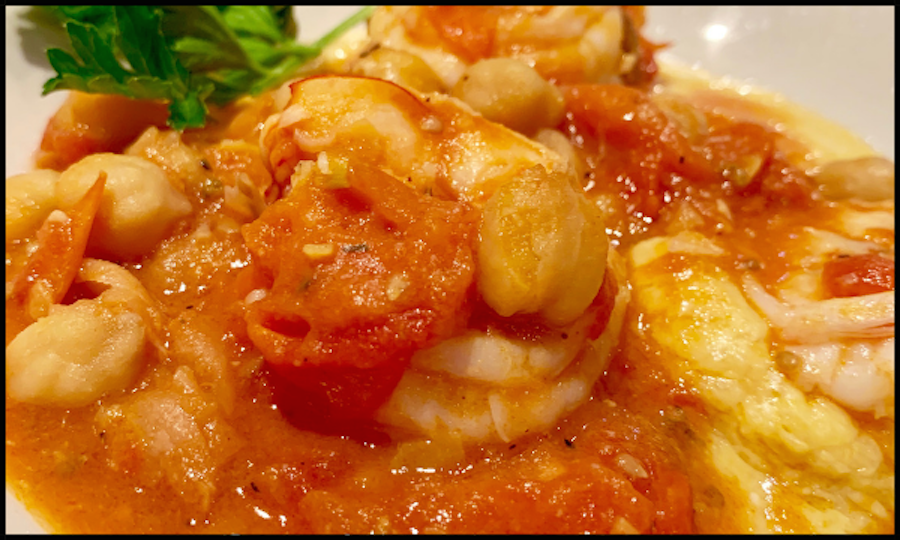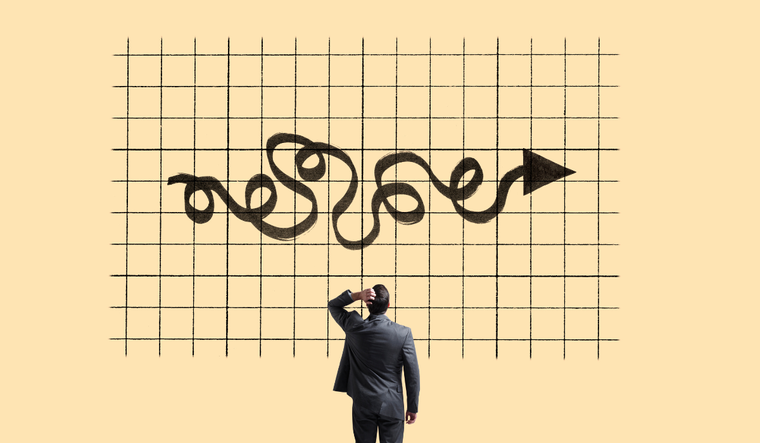Shrimp, Tomato, and Chickpea Stew
This is my back pocket recipe for when I want a satisfying, hearty meal that's ready to eat in half an hour. The combination of chickpeas and shrimp in a garlicky tomato broth is especially good over my creamy Pumpkin Polenta. Chickpeas (garbanzo beans) are one food that's common to all Blue Zones, the 5 places on earth with the most dementia-free centenarians. It's not surprising that eating chickpeas, or any other legume, is associated with longevity. The fiber in beans help regulate blood sugar, insulin levels, and cholesterol. Randomized trials show that eating legumes on a regular basis is associated with a slimmer waist, less diabetes, and lower blood pressure … all factors that reduce our risk of Alzheimer's and other dementias.
Serves 4-6
- ¼ cup extra virgin olive oil
- 3 cups cherry tomatoes (or 1 14-oz can crushed tomatoes)
- 2 teaspoons minced garlic
- ½ cup white wine
- 1 pound large shrimp (about 16-20), peeled and deveined
- 1 1/2 cups cooked chickpeas (about 1 15-oz can, rinsed)
- ½ teaspoon kosher or sea salt
- Freshly ground pepper, to taste
- 2 tablespoons fresh oregano leaves, finely chopped
- Place a large saucepan over medium heat. When the pan is hot, add the olive oil and heat just until it starts to shimmer. Add the cherry tomatoes and the salt, and cook over low-medium heat until the tomatoes start to burst, about 10 minutes.
- Add the garlic and cook for another 2 minutes, stirring to make sure nothing sticks to the bottom of the pot.
- Add the white wine and cook for a few minutes to reduce the sauce.
- Fold in the chickpeas and place the shrimp atop the simmering sauce. Cover the pot and cook over low-medium heat until the shrimp turn pink, about 5 minutes.
- Taste; adjust the salt and add freshly ground pepper.
- Just before serving, sprinkle with fresh oregano.
- Serve with Pumpkin Polenta (see recipe at brainhealthkitchen.com), cauliflower couscous or rice, or forbidden rice.
Brain Health Notes:
- Shrimp contains the brain healthy nutrients selenium, potassium, and iron.
- Shrimp and other shellfish (such as oysters and clams) contain a type of omega-3 fatty acid critical for reducing inflammation … EPA, or eicosapentaenoic acid. Your body uses EPA to keep blood vessels relaxed, prevent the formation of clots, and combat the inflammatory omega-6 fatty acids in the body.
- Canned chickpeas are just as nutritious as freshly cooked ones, but cooking chickpeas from scratch gives them a more al dente texture.
- Canned chickpeas can contain high levels of sodium; be sure to rinse them well or look for low sodium varieties.
BHK Cooking School Notes:
- When purchasing shrimp, look for head-off, peel-on wild American shrimp in season. Avoid shrimp that has been imported from other countries, especially Asia. (Tip: If the shrimp is already peeled, it has probably been processed overseas.)
- When heating extra virgin olive oil in a pan, be careful not to warm it past its smokepoint; right when it starts to shimmer, or change texture, add the food. This will quickly lower the temperature of the oil and prevent the heat from damaging its delicate polyphenols (antioxidant compounds) and monounsaturated fats.
- To cook from scratch, soak dried chickpeas overnight, drain, and simmer with fresh water until tender. Salt chickpeas in the last 5 minutes of cooking.
- Make it alcohol-free by omitting the wine.
- Make it vegan by omitting the shrimp.
- Other types of beans, such as cannellini or cranberry, would work well here.
- Other types of seafood, such as halibut, scallops, and mussels would be good simmered atop the tomato chickpea sauce. Adjust cooking times as needed.
Reposted from Annie Fenn, M.D. and the Brain Health Kitchen.
READ MORE STORIES THAT MOVE HUMANITY FORWARD
READ MORE STORIES THAT MOVE HUMANITY FORWARD
SIGN UP FOR MARIA’S SUNDAY PAPER
Please note that we may receive affiliate commissions from the sales of linked products.



